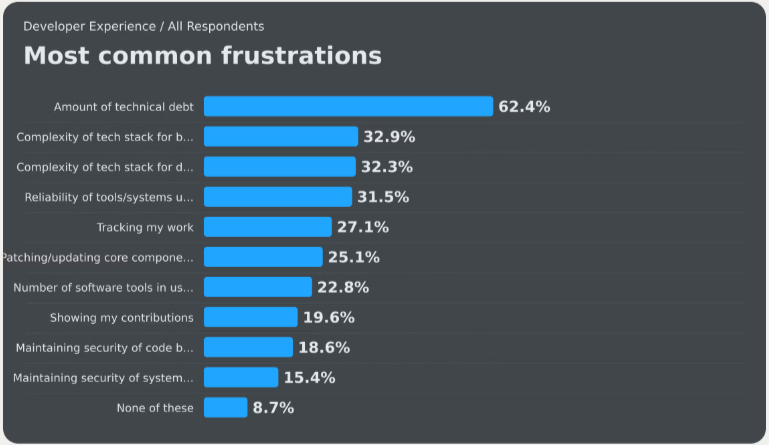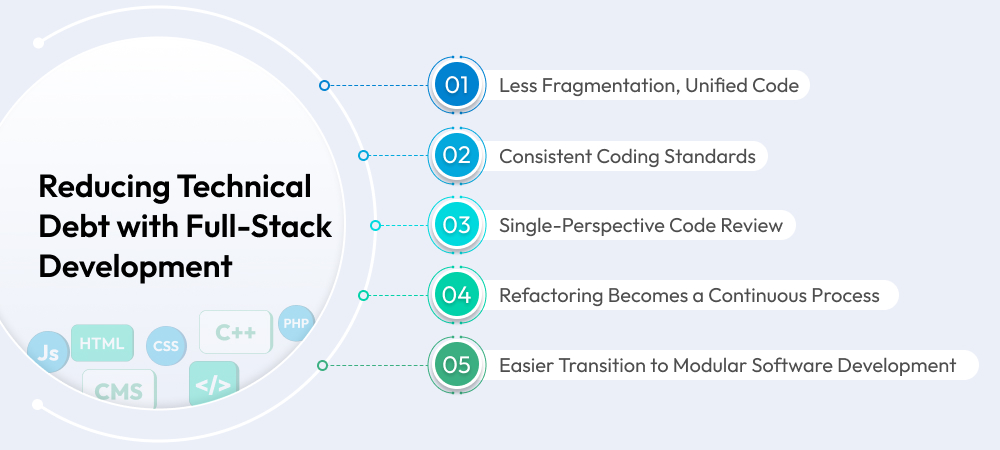
According to Accenture’s Tech Debt Report, IT leaders had significantly increased their spending on technical debt remediation from 2020 to 2023. Between 2020 and 2022, nearly 17% of their total budget was allocated to addressing technical debt, a figure that surpassed 24% in 2023.
This trend highlights a direct link between technological advancements and growing technical debt— as IT investments rise, so do the costs of maintaining and addressing accumulated inefficiencies. However, simply allocating more resources to debt remediation only works up to a point. Beyond that, it will only highlight a company’s inefficiencies and over-investment in areas that hinder growth, rather than those that drive it.
In this article, we’ll explore the hidden costs of technical debt, its consequences, and see how full-stack development provides a structured approach to mitigating them.
Breaking Down the Cost of Technical Debt
In the US alone, businesses incur annual technical debt costs of up to $2.41 trillion, with an estimated $1.52 trillion required for remediation. Imagine the same scenario on a global scale, with the numbers continuing to increase (as of now).
This is because technical debt is an unavoidable byproduct of software development. It accumulates over several years for multiple reasons, including changing business goals and context, inefficiencies in the development process, and the structure and quality of dev teams.
The core, however, is that in software development, developers sometimes opt for quick, easy workarounds instead of writing clean, well-structured code from scratch, often to meet tight deadlines, optimize resource utilization, and expedite market entry.
While it may seem to help in the short term, it actually nurtures vulnerabilities and issues, ultimately disrupting and slowing down development in the long term. Resolving these issues and optimizing performance often requires significantly more effort and resources than anticipated.
The Impact of Technical Debt
Technical debt is more than just coding gaps; it can result in multiple, everyday headaches for development teams and have significant financial implications if left unresolved. Here is how technical debt pans out:
1. Faster Development Now, Slower Growth Tomorrow
While it initially helps you move faster, it becomes increasingly difficult to build as your codebase grows. Developers will have to spend more time identifying the underlying issue, fixing messy code, and troubleshooting, which will slow down the overall project.
2. More Bugs and System Crashes
Quick fixes often result in fragile code. Over time, these fixes can lead to more bugs, system errors, and even app crashes.
3. Security Vulnerabilities
Taking shortcuts during development also makes it challenging to identify security flaws as crucial testing steps get skipped. These vulnerabilities can pile up, increasing the risk of data breaches and compliance issues.
4. Decision Paralysis for Product Teams
Technical debt also causes dilemmas and limits options for product managers. They have to prioritize activities, whether to innovate new features or to focus on technical clean-up and maintain the existing functionality only.
5. Hard-to-Scale Systems
Growing businesses must scale their software to handle more users, data, and features. However, with technical debt, your code isn’t flexible enough to accommodate more segments. Even simple additions can require massive rework.
And the list does not end here. Technical debt isn’t clearly just a coding issue; it’s a business bottleneck that, if left unattended, drains resources and frustrates your teams while also impacting their confidence and self-worth. In fact, according to Stack Overflow’s 2024 Annual Developer Survey, technical debt is the most common frustration for more than 62% of developers.

Reducing Technical Debt with Full-Stack Development
According to a report published by Stripe, developers spend nearly 13.5 hours a week reducing technical debt by managing disjointed code and refining short-term fixes for longer-term stability. To reduce this time, full-stack development has emerged as a proven approach to ensure better structure, consistency, and long-term sustainability and maintainability of code. Here is how:

1. Less Fragmentation, Unified Code
Technical debt issues often arise when front-end and back-end teams work in silos. However, with full-stack development, you work with developers who handle both the front-end (what users see) and the back-end (the server, database, and APIs). This approach gives you a strategic position to identify gaps and manage them proactively.
2. Consistent Coding Standards
With a connected development team, you can ensure consistency in coding styles, logic, documentation, and methodologies. This enforces uniformity in development practices, reducing the risk of rework and eliminating redundant code that adds to technical debt.
3. Single-Perspective Code Review
Unlike siloed teams, where front-end and back-end developers review code separately, full-stack developers review code holistically and recommend changes after analyzing the overall impact. This ensures that changes in one area don’t create compatibility issues elsewhere.
4. Refactoring Becomes a Continuous Process
With full-stack development, you can gradually internalize refactoring. Some developers can update outdated functions, streamline dependencies, and optimize performance, while others continue to build the software and add more functionalities.
5. Easier Transition to Modular Software Development
Full-stack developers often emphasize component-driven software development. This includes using API-first approaches for the back-end and pre-built libraries and templates for the front-end. Such development practices reduce technical debt by preventing you from getting stuck in “legacy lock-in,” a primary cause of rising technical debt.
The Full-Stack Paradox: How it Can Fuel Technical Debt
While full-stack development is a practical approach to preventing technical debt, it is also prone to slip-ups precisely because full-stack developers are responsible for both the front-end and back-end.
1. The “Shortcut Syndrome” is common, even with full-stack developers.
Like others, even full-stack developers can fall prey to the pressure. They often work across front-end, back-end, databases, and APIs, managing multiple tasks under tight deadlines. This pressure can tempt them to take shortcuts, such as:
- Skipping proper documentation for faster feature rollouts.
- Hardcoding quick fixes instead of building flexible, scalable solutions.
- Ignoring long-term maintainability by writing code that “just works” for now.
These patchwork code fixes result in nothing but highly fragile code that causes issues later on in the process.
2. Full-stack developers must handle the increased cognitive load.
In addition to coding, developers must also “think” about optimizing the front-end for end users, securing data flows and back-end APIs, managing databases, and periodically testing. This cognitive load (in addition to the actual execution) makes it difficult for them to focus on every aspect of the application, causing them to overlook individual performance optimizations.
3. There’s always a risk of developer burnout.
The breadth of responsibilities and workload full-stack developers handle also places them at a higher risk of burnout. Additionally, long hours, context-switching, collaborating with other teams, and proactive problem-solving also affect their productivity and decision-making capabilities.
It has been established that even this holistic approach to managing technical debt can be overwhelming, especially if implemented without experience and expertise. A foolproof strategy, in this case, will be to venture into full-stack development with the right level of professional support.
Solving the Full-Stack Paradox with Professional Support
Outsourcing Full-Stack Development to Experienced Teams or Hiring Dedicated Developers
The risks of shortcut fixes, cognitive overload, and developer burnout often stem from limited bandwidth, lack of expertise, and the pressure to deliver quickly. However, with external full-stack support, you can optimize the process and free up internal resources for other high-value tasks, such as innovating new solutions.
Whether you outsource the entire process to a reliable service provider or hire full-stack developers experienced in similar projects externally, you get:
- Assured code quality and consistency with structured collaboration
- Reduced technical debt accumulation through continuous refactoring and modular development
- Lower risk of burnout with distributed workloads
- Faster development cycles without compromising maintainability
This approach may initially be a considerable investment. However, it’s significantly more sustainable over the long term. Better oversight, thorough code reviews & audits, and proactive technical debt management will position you to build scalable and high-performing applications.
Final Thoughts
With rapid technological advancements, technical debt has been rising, and so has spending on remediation. However, as Accenture suggests, there’s a limit beyond which any additional investments in technical debt mitigation yield diminishing returns and can strain overall tech budgets. The key is to categorize your debt, identify its source, and prioritize what truly needs attention. In this write-up, we have explored how a full-stack approach can help you manage and optimize technical debt through proactive, holistic code management. Ready to see if this strategy works for your organization?


